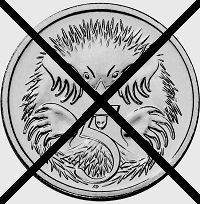In 1992 when the one and two cent coins were both demonetised and consigned to the dustbin of history, the two cent coin could buy roughly four cents worth of stuff today. By the end of 2017, that will have passed the five cent mark and if the two cent coin was worth getting rid of in 1992, then using that same logic the five cent coin should be abolished this year.
During the height of the mining boom in 2007, the value of the copper and nickel used to make the five cent coin, that is the value of the metal itself, was worth six and a half cents. Now that prices for metals have relaxed, although the value of the metal is now once again less than five cents it still begs the question of why the coin still exists.
The purpose of all coinage and indeed all money, be they banknotes or 4 tonne Rai stones which have been used as money in Micronesia, is the transfer of wealth in exchange for goods and services. The value of a dollar is whatever everyone decides what the value of a dollar happens to be. If the price of a kilo of carrots is two dollars, then the value of a dollar is half a kilo of carrots. The value of a dollar is only ever what it is capable of doing and the value of currency, is only ever to act as a marker of the transfer of wealth in exchange for goods and services - nothing more and nothing less. The five cent coin then, like all currency has as its only function, the facilitation of that purpose.
The problem is that, the five cent coin, on account of it being worth so little, mostly fails at its only function. The vending machines at train stations don't accept them and when people use them in the supermarket, I think that most of us resent the five cent coin's existence. I've found plenty of five cent coins left on the pavement because it simply wasn't worth people's time or effort to bother to pick them up.
That's worth considering, if it is literally not worth someone's effort to pick up a five cent coin, then that is a rational decision which has been made; this is an actual value judgement where the reward is exactly calculated. The service being exchanged is someone's time and effort for an exactly quantified amount of money and if people can't bothered to pick a five cent coin, then it should say something about the value of that unit of currency and whether or not it is worth making. If a two dollar coin was on the pavement, the reward for bothering to pick it up is forty times as much, even though the effort expended is exactly the same. In 2006, New Zealand reached the decision that its five cent coin was't worth keeping and got it of it as part of a currency revision.
I already think that the fifty, twenty, ten and five cent coins are too big for what they do. As it is, the five cent coin is based on the older £.s.d. sixpence which on that planchet size dates from 1816 when Mad King George III was still on the throne. Incidentally, the buying power of sixpence in 1816 would buy you not quite $130 worth of stuff now. Asking something to do a job for two hundred years is a bit of an ask.
Whilst I do think that the five dollar note should be replaced with a five dollar coin, simply because I find it easier to put coins through the checkout machines in supermarkets than having to fight with notes in the note acceptor, I think that the five cent coin has finally outlived its useful life. It's probably also worth adopting the same planchet sizes that New Zealand uses for its currency, or at very least using the ones for the ten, twenty and fifty cent coins.
If we do anything in 2017, let's get rid of the five cent coin. It's the change we can believe in because we don't believe that getting five cent coins in change is worth it - literally.
¹http://www.rba.gov.au/calculator/annualDecimal.html
²http://www.rba.gov.au/calculator/annualPreDecimal.html


No comments:
Post a Comment